Mariana of Austria
| Mariana of Austria | |||||
|---|---|---|---|---|---|
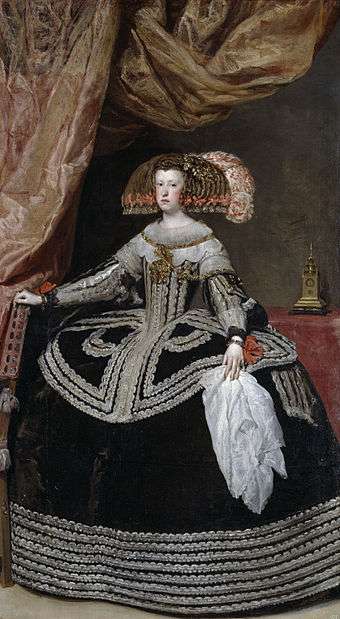 | |||||
| Queen consort of Spain | |||||
| Tenure | 7 October 1649 – 17 September 1665 | ||||
| Born |
24 December 1634 Wiener Neustadt, Austria | ||||
| Died |
16 May 1696 (aged 61) Uceda Palace, Madrid, Spain | ||||
| Burial | El Escorial | ||||
| Spouse | Philip IV of Spain | ||||
| Issue |
Margaret Theresa, Holy Roman Empress Philip Prospero, Prince of Asturias Charles II of Spain | ||||
| |||||
| House | Habsburg | ||||
| Father | Ferdinand III, Holy Roman Emperor | ||||
| Mother | Maria Anna of Spain | ||||
| Religion | Roman Catholic | ||||
Mariana of Austria (Maria Anna; 24 December 1634 – 16 May 1696) was Queen consort of Spain as the second wife of King Philip IV, who was also her maternal uncle. At the death of her husband in 1665, Queen Mariana became regent for her son Charles II, the last Spanish Habsburg, and she remained an influential figure during his reign.
Queen Mariana is also known as a benefactress for funding in the mid-17th century the Jesuit voyage of Blessed Father Diego Luis de San Vitores and Saint Pedro Calungsod to Guam, in order to Catholicize the indigenous Chamorro people of her namesake Mariana Islands.
Early life

Born as Maria Anna on 24 December 1634 in Wiener Neustadt, Austria, she was the granddaughter of Holy Roman Emperor Ferdinand II. Her parents were Crown Prince Ferdinand and Maria Anna of Spain, the sister of Maria Anna's future husband, King Philip IV of Spain. Her father, who would become Emperor in 1637, was as yet only King of Hungary and Bohemia, and was away for most of his wife's pregnancy campaigning in the Thirty Years' War. Her grandfather Emperor Ferdinand II died when she was 3 and her father became Holy Roman Emperor Ferdinand III.
Maria Anna, was the second of six children, three of which died in early childhood. Her oldest brother, Ferdinand IV of Hungary died young. Only Maria Anna and her younger brother, the future Holy Roman Emperor Leopold I, lived to reach old age.
Marriage

Maria Anna was destined from her early years to continue the policy of intermarriage between the two branches of the Habsburg family, the Austrian and the Spanish. In 1646 Maria Anna, then eleven years old, was engaged to her Spanish Habsburg first cousin Balthasar Charles, Prince of Asturias, heir of the Spanish crown. However, he died only three months later age 16. With Balthasar Charles's death, Philip IV was left without a male heir and Maria Anna without a fiancé. Philip was a widower, as his beautiful and beloved French wife, Elisabeth of France, had just died a few years prior. The forty-four-year-old Philip decided to marry his fourteen-year-old niece himself. After a marriage by proxy, they were wedded on 7 October 1649 in Navalcarnero, near Madrid, and spent their wedding night at El Escorial. From then on, she went by her name in Spanish, Mariana.
Mariana and Philip's marriage was not a happy one due to both Philip's infidelities and the age difference between them. Mariana "had nothing to do with governance" while her husband reigned, and her inexperience surely hindered her in her later regency. Instead she buried herself in religion to an extent that was excessive even for her time and place.[1]
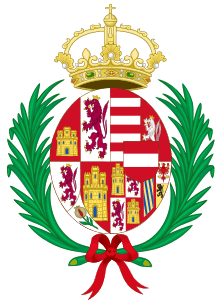
Mariana and Philip's marriage produced five children, however, only two lived into adulthood. Their first child was Margaret Theresa, who was born on 12 July 1651; just as her mother did, she went on to marry her own maternal uncle Leopold I, Holy Roman Emperor. In 1655, Mariana then had another daughter, Maria Ambrosia de la Concepción; she only lived fifteen days. During this time, there were those at court who wanted Philip to officially name his eldest daughter, Maria Theresa, as his heir, as she was already heir presumptive according to Spanish tradition. Mariana began feeling the pressure to have a son. Eventually, her first son, Philip Prospero, was born on 28 November 1657, who was joyously received. She then gave birth to the Infante Ferdinand Thomas in 1658, but he died a year later in 1659.
Sadly, her son Philip Prospero died in 1661. But that same year, Mariana gave birth to her last child, a son; he was named Charles and was born on 6 November.
Charles was born physically and mentally disabled. Possibly through affliction with mandibular prognathism, he was unable to chew. His tongue was so large that his speech could barely be understood, and he frequently drooled. It has been suggested that he suffered from the endocrine disease acromegaly, or his inbred lineage may have led to a combination of rare genetic disorders such as combined pituitary hormone deficiency and distal renal tubular acidosis.[2] Consequently, Charles II is known in Spanish history as El Hechizado ("The Hexed") from the popular belief – to which Charles himself subscribed – that his physical and mental disabilities were caused by "sorcery." The king went so far as to be exorcised.
Regency
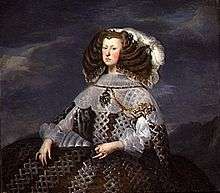
When Philip IV died on 17 September 1665, their only surviving son, Charles, was only 3 years old, and Mariana served as regent, relying on her confessor, Juan Everardo Nithard, for support until his dismissal in 1669. Charles, at most times unable to walk or speak, needed a regent more than most child kings, and was carried as an infant in an adult's arms until he was 10. In 1668, a voyage led by Jesuit missionary San Vitores named the Mariana Islands in the North Pacific after the queen regent.[3] Also that year, Spain entered the War of Devolution; it lost most of its land in the Spanish Netherlands to France. Mariana served as his regent for much of his life. She suffered greatly upon receiving the news of the death of her daughter, the Holy Roman Empress, Margaret Theresa, in Vienna in 1673. In 1675, her son Charles reached the age he needed to be to rule, however, Mariana continued to rule most of the time due to her son's illnesses. In 1677, Mariana was driven from Madrid by John of Austria the Younger, an illegitimate son of Philip IV. The palace coup was due to widespread dissatisfaction at court with her support for her adviser and favorite Fernando de Valenzuela, who was also rumored to be her lover.[4] She went to live in Toledo, but returned to Madrid upon John's death in 1679.
Later life

That same year, her son Charles II married the French princess Marie Louise d'Orléans. Although he was madly in love with her, their marriage remained childless. Ten years later, in 1689, Marie Louise died under mysterious circumstances. At the time, there were rumours saying that she had been poisoned by the notorious intrigante Olympia Mancini, Countess of Soissons, at the behest of Mariana, the dowager queen, because Marie Louise had not given birth to any children.[5] This is questionable as Mariana and Marie Louise were close and the dowager queen was also visibly devastated at the young Marie Louise's death. It seems likely that the real cause of her death was appendicitis or food poisoning.[6]
Charles married again, this time a German princess: Maria Anna of Neuburg. However, this second marriage was also childless. His new wife was on very bad terms with the Queen Mother. Mariana wanted her great-grandson, Joseph Ferdinand of Bavaria, to become the next King of Spain, which led to frequent arguments with her second-daughter-in-law, Maria Anna of Neuburg, who promoted her nephew, Archduke Charles of Austria, as the heir to Spain. As her great-grandson, Joseph Ferdinand died in childhood. Mariana has no descendants today.
Death
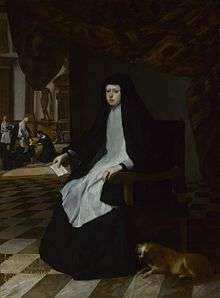
Mariana died of breast cancer on the night of 16 May 1696 at the Uceda Palace in Madrid, Spain. She was sixty-one years old.[1]
Issue
- Margaret Theresa (12 July 1651 – 12 March 1673), first wife of Leopold I, Holy Roman Emperor
- Maria Ambrosia de la Concepción (7 December 1655 – 21 December 1655)
- Philip Prospero, Prince of Asturias (28 November 1657 – 1 November 1661)
- Ferdinand Thomas Charles (23 December 1658 – 22 October 1659)
- Charles II of Spain (6 November 1661 – 1 November 1700)
Legacy
Portraiture
The official portrait of Mariana painted by Diego Velázquez was commissioned by the king and is the only known full length portrait of her. It is also the most famous one of her and today it hangs in the Prado Museum in Madrid. The painting was copied, and one of the copies hangs in the Kunsthistorisches Museum in Vienna. The original portrait was not completed until 1652.
Several portraits of her were painted. She is the subject of Juan Bautista Martínez del Mazo's Queen Mariana of Spain in Mourning, 1666. She also appears in other Velazquez works. She appears in Las Meninas as an image in a reflection with her husband, with her daughters as the main subject. She is the main subject of his 1660 Portrait of Mariana as a grieving widow.
Ancestors
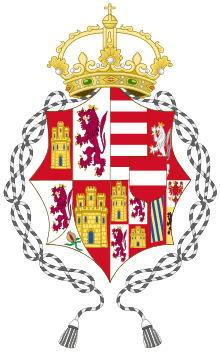
| 16. Ferdinand I, Holy Roman Emperor (= 28) | ||||||||||||||||
| 8. Charles II of Austria (= 14) | ||||||||||||||||
| 17. Anna of Bohemia and Hungary (= 29) | ||||||||||||||||
| 4. Ferdinand II, Holy Roman Emperor | ||||||||||||||||
| 18. Albert V, Duke of Bavaria (= 20, 30) | ||||||||||||||||
| 9. Maria Anna of Bavaria (= 15) | ||||||||||||||||
| 19. Anna of Austria (= 21, 31) | ||||||||||||||||
| 2. Ferdinand III, Holy Roman Emperor | ||||||||||||||||
| 20. Albert V, Duke of Bavaria (= 18, 30) | ||||||||||||||||
| 10. William V, Duke of Bavaria | ||||||||||||||||
| 21. Anna of Austria (= 19, 21, 31) | ||||||||||||||||
| 5. Maria Anna of Bavaria | ||||||||||||||||
| 22. Francis I, Duke of Lorraine | ||||||||||||||||
| 11. Renata of Lorraine | ||||||||||||||||
| 23. Christina of Denmark | ||||||||||||||||
| 1. Mariana of Austria, Queen of Spain | ||||||||||||||||
| 24. Charles V, Holy Roman Emperor | ||||||||||||||||
| 12. Philip II of Spain | ||||||||||||||||
| 25. Isabella of Portugal | ||||||||||||||||
| 6. Philip III of Spain | ||||||||||||||||
| 26. Maximilian II, Holy Roman Emperor | ||||||||||||||||
| 13. Anna of Austria | ||||||||||||||||
| 27. Maria of Spain | ||||||||||||||||
| 3. Maria Ana of Spain | ||||||||||||||||
| 28. Ferdinand I, Holy Roman Emperor (= 16) | ||||||||||||||||
| 14. Charles II of Austria (= 8) | ||||||||||||||||
| 29. Anna of Bohemia and Hungary (= 17) | ||||||||||||||||
| 7. Margaret of Austria | ||||||||||||||||
| 30. Albert V, Duke of Bavaria (= 18, 20) | ||||||||||||||||
| 15. Maria Anna of Bavaria (= 9) | ||||||||||||||||
| 31. Anna of Austria (= 19, 21) | ||||||||||||||||
References
- 1 2 Graziano, Frank (2003). Wounds of Love : The Mystical Marriage of Saint Rose of Lima. Oxford University Press. pp. 106–107.
- ↑ Gonzalo Alvarez; Francisco C. Ceballos; Celsa Quinteiro (April 15, 2009). "The Role of Inbreeding in the Extinction of a European Royal Dynasty". 4 (4). PLoS ONE: e5174. doi:10.1371/journal.pone.0005174. PMC 2664480
 . PMID 19367331. Retrieved 2009-04-16.
. PMID 19367331. Retrieved 2009-04-16. - ↑ Tucker, Spencer (2009). The encyclopedia of the Spanish-American and Philippine-American wars: a political, social, and military history. ABC-CLIO. p. 379. ISBN 1-85109-951-4.
- ↑ Hume, Martin Andrew Sharp (1899). Spain: Its Greatness and Decay. 1479-1788. Spain: University Press. Retrieved 24 August 2014.
- ↑ Latour, pages 203–04
- ↑ Claude Dulong, Claude (1993). Marie Mancini. Perrin. p. 320.
Titles
| Mariana of Austria Born: 23 December 1634 Died: 16 May 1696 | ||
| Spanish royalty | ||
|---|---|---|
| Vacant Title last held by Elisabeth of France |
Queen consort of Spain 7 October 1649 – 17 September 1665 |
Vacant Title next held by Marie Louise of Orléans |
